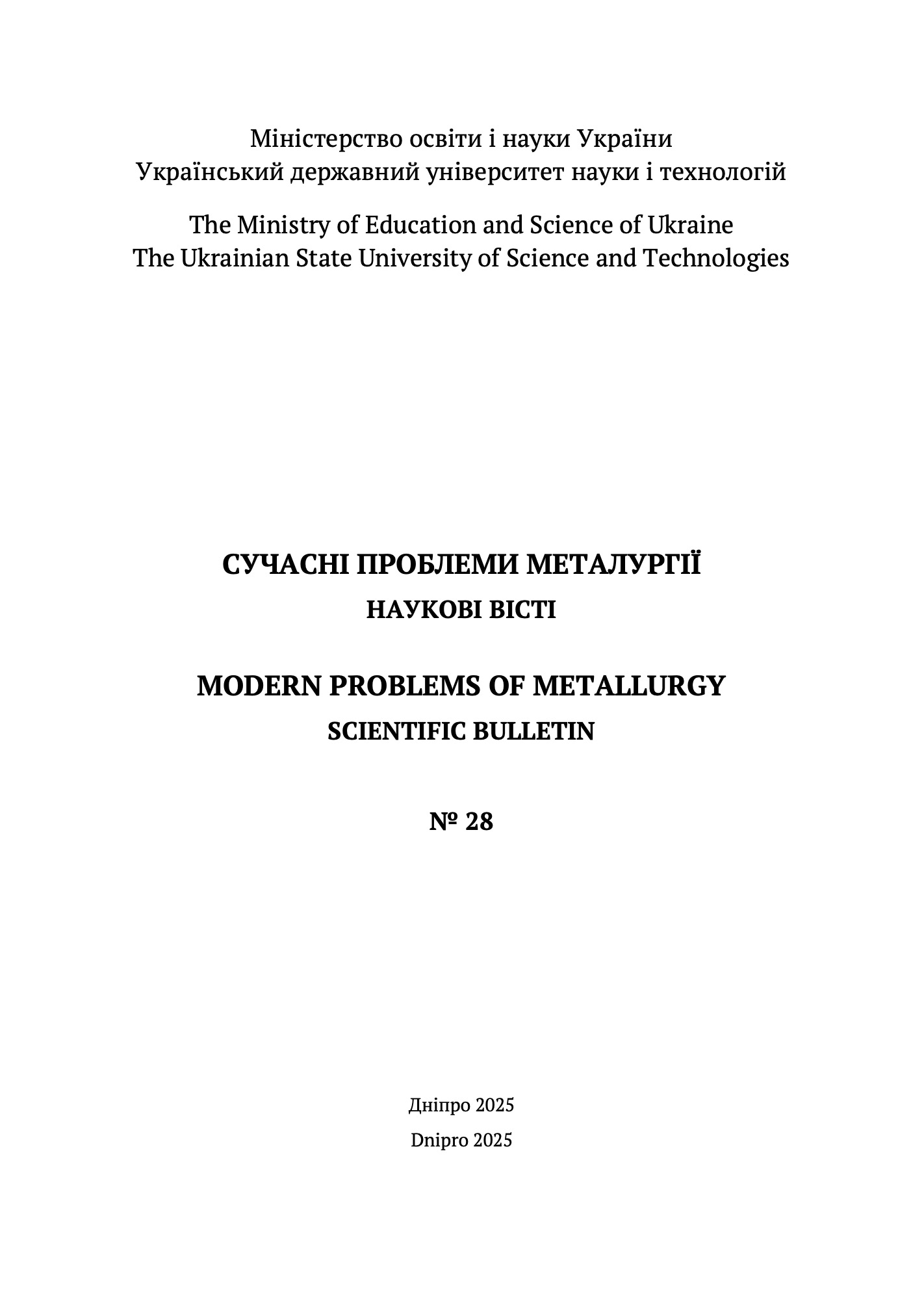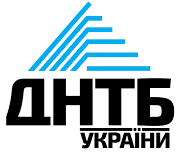THE CURRENT STATE OF SAWDUST PROCESSING OF CHIPBOARD AND IRON-CONTAINING METALLURGY WASTE
DOI:
https://doi.org/10.34185/1991-7848.2025.01.21Keywords:
electric arc furnace, dust, zinc, carbon, technology, thermodynamicsAbstract
The object of the study is the metallurgical technology of chipboard dust processing and iron-containing waste from metallurgical production.
The purpose of the work is the analysis of physical and chemical processes, experimental research and the development of innovative technological solutions and recommendations for chipboard dust and iron-containing metallurgical waste.
Research methods – theoretical research is based on the basic principles of physical chemistry and the theory of metallurgical processes. Calculations of the thermodynamic equilibrium of oxide systems are based on the Gibbs theory and implemented using the computer program "FASTSage 6.0"; the chemical composition of the phase components of manganese ferroalloys was studied using a scanning electron microscope YSM-6300LA from JEOL, Japan.
Scientific novelty. Effective removal of zinc from chipboard dust is already possible at moderate temperatures of 1000...1100oC, including when using substandard carbon materials as a carbon reducer. To obtain a liquid product, it is necessary to provide an excess amount of carburizing carbon to lower the temperature of the resulting melt.
At temperatures of the order of 1000...1100°С, iron-containing dust and sludge undergo changes, which leads to a decrease in the content of Zn in the processed material, the transition of the original dust-like materials into a compact mass.
Practical meaning. The joint processing of chipboard slag and dust by dosing in different proportions is not rational, because in this case the concentration of zinc collected in the gas cleaning processing unit is reduced. It will be more effective to organize alternate processing of chipboard dust and slag at different time periods (for example, monthly).
References
European Union. EUR-Lex: Access to European Union Law [Electronic resource] / European Union. — Access mode: http://eur-lex.europa.eu
Jordan Daci. EU Law on waste management and shipment: some main legal issues for metal industry in the European Union. 2011. “Education in ‘turbulent times’; the Albanian case in European and global context” 6th International Conference of the Albanian Institute of Sociology (Proceedings, I) See discussions, stats, and author profiles for this publication at: https://www.researchgate.net/publication/326625660
Techno-economic study on the reduction measures, Best Available Technologies, of water discharges and waste generation from the primary and secondary iron and steel industry. Final report: 09.1993.
Jaakko Pöyry. Techno-economic study on the reduction measures, based on best available techniques of emissions (water, wastes, air) from the paper and board manufacturing industry. 1996. Luxembourg : Off. for Official Publ. of the Europ. Communities
Integrated Pollution Prevention and Control (IPPC). Best Available Techniques Reference Document on the Production of Iron and Steel. European Commision. December 2001. http://eippcb.jrc.ec.europa.eu/pages/FActivities.htm.
Integrated Pollution Prevention and Control (IPPC). Draft reference Document on Best Available Techniques for the Production of Iron and Steel. European Commision. Draft February 2008. https://eippcb.jrc.ec.europa.eu/sites/default/files/2019-11/IS_Adopted_03_2012.pdf
Найкращі доступні технології та методи управління (НДТМ) Довідковий документ для виробництва чавуну та сталі Директива 2010/75/ЄС «Про промислове забруднення (інтегроване запобігання та контроль забруднення)» Автори: Райнер Ремус, Мігель А. Агуадо-Монсоне, Серж Рудьє, Луїс Дельгадо Санчо. 2013. https://mepr.gov.ua/files/docs/Atmosferne_povitria/NDTN/21.12.2022/IS_Adopted_03_2012_ukr_ed(2).pdf
European Commission. BAT Note – Ferrous Metal Processing – Final Draft – August 2012 [Electronic resource] / European Commission. — Access mode: https://www.epa.ie/publications/licensing--permitting/industrial/ied/BAT-Note---Ferrous-Metal-Processing---Final-Draft---August-2012---SH.pdf .
European Union. Management of Waste from Extractive Industries [Electronic resource] / European Union. — Access mode: https://eur-lex.europa.eu/EN/legal-content/summary/management-of-waste-from-extractive-industries.html.
WeCoop. EU Policies and Regulations [Electronic resource] / WeCoop. — Access mode: https://wecoop.eu/regional-knowledge-centre/eu-policies-regulations/.
European Union. European Union Publication Detail [Electronic resource] / European Union. — Access mode: https://op.europa.eu/en/publication-detail/-/publication/eaa047e8-644c-4149-bdcb-9dde79c64a12 .
European Commission. EIPPCB - European Integrated Pollution Prevention and Control Bureau [Electronic resource] / European Commission. — Access mode: http://eippcb.jrc.ec.europa.eu .
Kiran Kumar, T., Roy, G.G. A Review on Processing of Electric Arc Furnace Dust (EAFD) by Pyro-Metallurgical Processes. Trans Indian Inst Met 75, 1101–1112 (2022). https://doi.org/10.1007/s12666-021-02465-6.
World steel Association, 2019. World Steel Association, SteelStatistical Yearbook 2019; Available on Internet: http://www.worldsteel.org/statistics/statistics-archive/yearbook-archive.html
Machado J. M. da Silva, Brehm F. Andrade, Carlos A.M. Moraes, Carlos A. dos Santos. Caracterization study of electric arc furnace dust phases // Materials Reserch. 2006. N 9 (1). P.25-36. https://doi.org/10.1590/S1516-14392006000100009
Jalkanen H., Oghbasilasie H., Raipala K. Recycling of steelmaking dust – the RADUST concept // Journal of Mining and Metallurgy. 2005. N 41. P.1-16. https://doi.org/10.2298/JMMB0501001J.
Xiaolong Lin, Zhiwei Peng, Jiaxing Yan, Zhizhong Li, Jiann-Yang Hwang, Yuanbo Zhang, Guanghui Li,Tao Jiang. Pyrometallurgical recycling of electric arc furnace dust. Journal of Cleaner Production. Volume 149, 15 April 2017, Pages 1079-1100. https://doi.org/10.1016/j.jclepro.2017.02.128.
R.L. Nyirenda. The processing of steelmaking flue-dust: A review. // Minerals Engineering. Volume 4, Issues 7–11, 1991, Pages 1003-1025. https://doi.org/10.1016/0892-6875(91)90080-F
Mamdouh Omrana, Timo Fabritiusa. Utilization of blast furnace sludge for the removal of zinc from steelmaking dusts using microwave heating. // Separation and Purification Technology. Volume 210, 8 February 2019, Pages 867-884. https://doi.org/10.1016/j.seppur.2018.09.010.
Zhengqi Guo, Ruoning Zhan, Yue Shi, Deqing Zhu, Jian Pan, Congcong Yang, Yige Wang, Jin Wang. Innovative and green utilization of zinc-bearing dust by hydrogen reduction: Recovery of zinc and lead, and synergetic preparation of Fe/C micro-electrolysis materials. // Chemical Engineering Journal. Volume 456, 15 January 2023, Р. 141-157. https://doi.org/10.1016/j.cej.2022.141157
Yang Xue, Xiansheng Hao, Xiaoming Liu, Na Zhang. Recovery of Zinc and Iron from Steel Mill Dust—An Overview of Available Technologies. Materials, 2022, 15, 4127. https://doi.org/10.3390/ma15124127
R. O. McElroy, Murray Mcclaren. Processing of electric arc furnace dust via chloride hydrometallurgy. 1994. (pp.993-1010). Hydrometallurgy.
https://doi.org/10.1007/978-94-011-1214-7_68
23. José Alencastro de Araûjo, Valdir Schalch. Recycling of electric arc furnace (EAF) dust for use in steel making process.//Journal of Materials Research and Technology. 2014. http://dx.doi.org/10.1016/j.jmrt.2014.06.003.
Manuel Leuchtenmüller, Ulrich Brandner. The catalytic effect of the metal bath on the zinc oxide reduction. // Results in Engineering. Volume 16, December 2022. https://doi.org/10.1016/j.rineng.2022.100514
J.R.Donald, C.A.Pickles. Reduction of electric arc furnace dust with solid iron powder. // Canadian Metallurgical Quarterly. Volume 35, Issue 3, July–September 1996, Pages 255-267. https://doi.org/10.1016/0008-4433(96)00009-2.
D.Colbert, G.A. Irons. Electric arc furnace dust injection into iron and steel melts. // Canadian Metallurgical Quarterly. 2006. 45(1):1-8. https://doi.org/10.1179/000844306794409057.
Mamdouh Omran, Timo Fabritius, Yaowei Yu, Eetu-Pekka Heikkinen, Guo Chen, Yilmaz Kacar. Improving Zinc Recovery from Steelmaking Dust by Switching from Conventional Heating to Microwave Heating. // Journal of Sustainable Metallurgy, volume 7, p.15–26. 2021. https://doi.org/10.1007/s40831-020-00319-x
M.C. Mantovani, C. Takano, P.M. Büchler. EAF and secondary dust characterisation. // Ironmaking & Steelmaking. Processes, Products and Applications. Volume 31, 2004 - Issue 4. Pages 325-332. https://doi.org/10.1179/030192304225018163
Xue Bing Li, Wei Wang, Dong Hai Zhang, Li Xiong. Basic Properties of Iron and Steel Making Dust. // Advanced Materials Research. 2014. Volume 937. 187-190. https://doi.org/ 10.4028/www.scientific.net/AMR.937.187.
Ashraf Bakkar. Recycling of electric arc furnace dust through dissolution in deep eutectic ionic liquids and electrowinning. // Journal of Hazardous Materials. 2014. 280(9–10):191–199. https://doi.org/10.1016/j.jhazmat.2014.07.066/
D. Mombelli, C.Di Cecca, C. Barella, E. Bondi. Experimental analysis on the use of BF-sludge for the reduction of BOF-powders to direct reduced iron (DRI) production. // Process Safety and Environmental Protection. Volume 102, 2016, P. 410-420. https://doi.org/10.1016/j.psep.2016.04.017
Machado J. M. da Silva, Brehm F. Andrade, Carlos A.M. Moraes, Carlos A. dos Santos. Caracterization study of electric arc furnace dust phases // Materials Reserch. 2006. N 9 (1). P.25-36. https://doi.org/10.1590/S1516-14392006000100009
Pan Hengyu, Xiaohong Zhang, Jun Wu, Yanzong Zhang, Lili Lin, GangYang, Shihuai Deng, LiLi, Xiaoyu Yu, Hui Qi, Hong Peng. Sustainability evaluation of a steel production system in China based on emergy. // Journal of Cleaner Production. Volume 112, Part 2, 2016, Pages 1498-1509. https://doi.org/10.1016/j.jclepro.2015.05.019
Stewart, D.J.; Barron, A.R. Pyrometallurgical removal of zinc from basic oxygen steelmaking dust. // A review of best available technology. Resour. Conserv. Recycl. 2020, 157, 104746. https://doi.org/10.1016/j.resconrec.2020.104746
Yu-liang Wu, Ze-yi Jiang, Xin-xin Zhang, Peng Wang, Xue-feng She. Numerical simulation of the direct reduction of pellets in a rotary hearth furnace for zinc-containing metallurgical dust treatment. // International Journal of Minerals, Metallurgy, and Materials volume 20, pages 636–644 (2013). https://doi.org/10.1007/s12613-013-0777-5.
Holtzer M., Kmita A., Roczniak A. The recycling of materials containing iron and zinc in the OxyCup Process. // Arch. Foundry Eng. 2015, 15, 126–130.
Hillmann C., Sassen K.J. Processing of zinc-bearing BOF dusts in a blast furnace. // World Iron Steel 2013, 5, 8–9. https://www.dk-duisburg.de/wp-content/uploads/Artikel-Steelmaking-2014.pdf
Yamada S., Itaya H., Hara Y. Simultaneous recovery of zinc and iron from electric arc furnace dust with a coke-packed bed smelting-reduction process. // Iron Steel Eng. 1998, 75, 64–67.
Felix A. López, Aurora López-Delgado. Enhancement of Electric Arc Furnace Dust by Recycling to Electric Arc Furnace. // Journal of Environmental Engineering. 2002. 128(12). https://doi.org/10.1061/(ASCE)0733-9372(2002)128:12(1169)
N. Antuñano, J.F. Cambra, P.L. Arias. Hydrometallurgical processes for Waelz oxide valorization. // An overview. Process Saf. Environ. Prot. 2019, 129, 308–320. https://doi.org/10.1016/j.psep.2019.06.028
Coronado M., Andres A., Cheeseman C.R. Acid gas emissions from structural clay products containing secondary resources: Foundry sand dust and Waelz slag. // J. Clean. Prod. 2016, 115, 191–202. https://doi.org/10.1016/j.jclepro.2015.11.083
Suetens T., Klaasen B., Van Acker K., Blanpain B. Comparison of electric arc furnace dust treatment technologies using exergy efficiency. // J. Clean. Prod. 2014, 65, 152–167. https://doi.org/10.1016/j.jclepro.2013.09.053
A. Magdziarz, M. Kuźnia, M. Bembenek, P. Gara, M. Hryniewicz Briquetting of EAF Dust for its Utilisation in Metallurgical Processes. // Chem. Process Eng., 2015, 36 (2), 263-271. https://doi.org/10.1515/cpe-2015-0018
Chunbao Xu, Shengli Wu, Daqiang Cang. Numerical Modeling of NO Formation during Packed-bed Combustion of Coke Granules. // J. Univ. Sci. Technol. Beijing, 7(2000), No. 4, pp. 261-268.
Xu T., Ning Xj., Wang Gw. et al. Combustion characteristics and kinetic analysis of co-combustion between bag dust and pulverized coal. // Int J Miner Metall Mater 25, 2018, 1412–1422. https://doi.org/10.1007/s12613-018-1695-3
Wang M., Liu X. Applications of red mud as an environmental remediation material: A review. // J. Hazard. Mater. 2021, 408, 124-420. https://doi.org/10.1016/j.jhazmat.2020.124420
Yang Xue, Xiaoming Liua. Detoxification, solidification and recycling of municipal solid waste incineration fly ash: A review. // Chemical Engineering Journal. Volume 420, Part 3, 2021, 130-349. https://doi.org/10.1016/j.cej.2021.130349
Hui-ning Zhang, Jian-li Li, An-jun Xu, Qi-xing Yang, Dong-feng He, Nai-yuan Tian. Carbothermic Reduction of Zinc and Iron Oxides in Electric Arc Furnace Dust. // Journal of Iron and Steel Research International. Volume 21, 2014, pages 427–432. https://doi.org/10.1016/S1006-706X(14)60066-2
Wei Zhang, Xiaoming Liu, Yaguang Wang, Zepeng Li, Yong Li, Yongyu Ren. Binary reaction behaviors of red mud based cementitious material:Hydration characteristics and Na+ utilization. // Journal of hazardous materials, 410, 124-592. https://doi.org/10.1016/j.jhazmat.2020.124592
C.A. Pickles, Omid Marzoughi. Thermodynamic analysis of metal speciation during the chlorosulphation of electric arc furnace dust. // Minerals Engineering. 2019. 140:105874. https://doi.org/10.1016/j.mineng.2019.105874
Pickles C.A. Thermodynamic analysis of the selective chlorination of electric arc furnace dust. // Journal of Hazardous Materials. 2009. 166(2-3):1030-42. https://doi.org/10.1016/j.jhazmat.2008.11.110.
Havlík T., Souza B.V., Bernardes A.M., Schneider I.A.H., MiškufováA. Hydrometallurgical processing of carbon steel EAF dust. // J. Hazard. Mater. 2006, 135, 311–318. https://doi.org/10.1016/j.jhazmat.2005.11.067
Peng Wei, Wenzhou Yu, Hao Chen, Weiyan Jiang. A New Strategy for Collaborative Utilization of Red Mud and Coal Fly Ash via Vacuum Reduction Technology. // Journal of Sustainable Metallurgy. 2022. 8(3) https://doi.org/10.1007/s40831-022-00578-w.
J. Buzin. EAF dust: an overview on the influences of physical, chemical and mineral features in its recycling and waste incorporation routes. // Journal of Materials Research and Technology. Volume 6, Issue 2, 2017, Pages 194-202. https://doi.org/10.1016/j.jmrt.2016.10.002
Sylwia Oleszeka, Mariusz Grabda, Etsuro Shibata, Takashi Nakamura. Fate of lead oxide during thermal treatment with tetrabromobisphenol. // Journal of Hazardous Materials. Volume 261, 2013, Pages 163-171. https://doi.org/10.1016/j.jhazmat.2013.07.028
Tahir Sofilić, V. Novosel-Radovi, S. Cerjan-Stefanovic, A. Rastovcan-Mioc. The mineralogical composition of dust from an electric arc furnace. // Materials and Technologies. 2005. 39(5):149-154.
Tahir Sofilić, Alenka Rastovcan-Mioc, Stefica Cerjan-Stefanović, Vjera Novosel-Radović, Monika Jenko. Characterization of steel mill electric-arc furnace dust. // J Hazard Mater. 2004 Jun 18;109(1-3):59-70. https://doi.org/10.1016/j.jhazmat.2004.02.032.
Man-made materials in the production processes of metals and alloys. Monograph. Kamkina Lyudmila, Myanovska Yana, Proydak Yuriy, Proydak Andriy. Under the author's editorship. Dnipro: PBP "Economica", 2022. 352 p. ISBN 978-966-2637-73-1.
A. A. Khil’ko, L. M. Simonyan, A. A. Lysenko, O. V. Astashkina, A. A. Mikhalchan. Morphology of steel electrofurnace dust. // Steel Transl. 2013, 43, 254–257. https://doi.org/10.3103/S0967091213050070.
Laura M. Simonyan, Anna A. Alpatova, Nadezhda V. Demidova. The EAF dust chemical and phase composition research techniques. // Journal of Materials Research and Technology. Volume 8, Issue 2, April 2019, Pages 1601-1607. https://doi.org/10.1016/j.jmrt.2018.11.005
Y. Projdak, L. Kamkina, Y. Mianovska. Micro-X-ray spectral determination of the chipboard dust samples elemental composition. // System technologies. Vol. 3. No. 140 (2022). Р. 181-192. https://doi.org/10.34185/1562-9945-3-140-2022-15.
Tsubouchi N, Hashimoto H, Ohtaka N, Ohtsuka Y. Chemical characterization of dust particles recovered from bag filters of electric arc furnaces for steelmaking: some factors influencing the formation of hexachlorobenzene. //J Hazard Mater. 2010. Nov 15; 183(1-3):116-24. https://doi.org/10.1016/j.jhazmat.2010.06.122.
Suetens T., Guo M., Van Acker K., Blanpain B. Formation of the ZnFe2O4 phase in an electric arc furnace off-gas treatment system. // J Hazard Mater. 2015. Apr 28; 287:180-7. https://doi.org/10.1016/j.jhazmat.2015.01.050.
Suetens T., Guo M., Acker K.V. et al. Zn Loss into ZnFe2O4 in an Open Type Electric Arc Furnace: An In-Process Separation Performance Model. // J. Sustain. Metall. 1, 297–303 (2015). https://doi.org/10.1007/s40831-015-0033-5.
Касимов А.М., Тошинский В.И., Романовский А.А. Основные физико-химические свойства цинксодержащих отходов газоочисток металлургических агрегатов // Вісник МСУ /Vestnik MSU/. Технічні науки. – 2006. - Т. ІХ. - № 1. - С. 9-13.
Kashiwaya Y., Tsubone A., Ishii K., Sasamoto H. Thermodynamic Analysis on the Dust Generation from EAF for the Recycling of Dust. // ISIJ International, Vol. 44 (2004), No. 10, pp. 1774–1779. https://doi.org/10.2355/isijinternational.44.1774
Jensen J.T. Reduction of EAF dust emissions by injecting it into furnace. // Metallurgical plant and technology internsational. - 1997. - №3. - P. 58-62. Reprint from "MPT-Metallurgical Plant and rechnology International" issue No. g/.l997, p. 58-62.
Downloads
Published
Issue
Section
License
Copyright (c) 2025 Modern Problems of Metallurgy

This work is licensed under a Creative Commons Attribution 4.0 International License.












